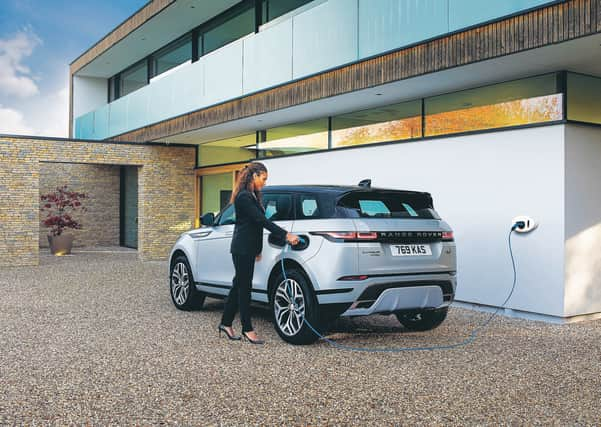Eclectic Electrics: The wide choice of options for drivers who want to reduce their impact on the planet


In the first three months of this year electrified vehicles outsold diesel cars, which have slumped by 51 per cent. The trend, then, is toward low and zero-emission cars.
Ownership hotspots for plug-in hybrids by postcode include Aberdeen 1,217, Glasgow has nearly 5,000, Edinburgh 2,267, Dumfries 218, Dundee 765, Falkirk 1,563, Inverness 402, Kilmarnock 516, Kirkcaldy 832, Motherwell 628, Paisley 541. There are 51 on Shetland, 250 on Orkney and just 34 in the Hebrides. (Figures: SMMT.)
Advertisement
Hide AdAdvertisement
Hide AdThe distinction between electrified cars is straightforward. The hybrid runs on a mix of electric power and liquid fuel, usually petrol. They are known as self-charging hybrids. The large and heavy electric battery in the car floor is charged from the braking energy of the car and from the engine. It is almost free energy. The blending of power is managed by the car’s electronics, fed to the wheels through an automatic gearbox in a seamless flow. You can coax them along on pure battery power but not for long. The main engine soon engages. They are economical and reduce emissions, and are typically powerful and enjoyable to drive. The battery gives an immediate and maximum thump of torque – akin to turning on an electric mower or kitchen appliance.
The world’s best-seller is the Toyota Prius, one of the pioneers. The same units are used on other Toyotas, like the UK-built Corolla, the CH-R, Camry and the RAV4. On a recent test for this paper a Prius with all-wheel-drive averaged up to 60 miles a gallon. Its CO2 rating is 85g/km. They are ideal for everyday use, touring holidays, and a favourite for taxi fleets. Toyota’s luxury Lexus brand uses the same power units and has the widest range of self-charging premium hybrids.
The main variation of the self-charging hybrid is the plug-in hybrid electric vehicle, known as a PHEV. This has the advantage of boosting the motor battery with mains electricity, using a heavy-duty, dedicated charging cable from socket to car. With a full battery they can run without the combustion engine for 20, 30 or even 40 miles. In this mode they are a zero-emission vehicle. If you keep the battery charged between journeys then fuel economy can be remarkable. For maximum economy, they suit drivers with a low daily mileage. When the battery is empty, fuel economy drops alarmingly.
Mitsubishi’s Outlander is a PHEV favourite. This 4x4 SUV has a 2.4 petrol engine and an electric motor, With an electric range of 28 to 35 miles, it is rated at 46g/km and 122 to 156mpg. Business and company drivers get payroll tax gains based on these ratings. A standard 3-pin domestic plug will charge the battery in seven hours. A dedicated home charger or supermarket charge station takes four hours. Commercial rapid chargers found at service stations will give an 80 per cent charge in 25 minutes. These figures are typical for all PHEVs.
The latest PHEVs are the Land Rover Evoque and Discovery. Headline figures for the Evoque are 41 miles on pure electric power, 32g CO2 and “up to” 201mpg and 0-60mph in 6.1 seconds. In normal times I would be driving these cars. The new Defender media launch should have been this week. There will be a hybrid version. Like potential buyers, I shall have to wait.
Jaguar Land Rover has had to postpone deliveries. All carmakers welcome inquiries through dealers or websites. They will also advise on what to do if a PCP contract is expiring, warranty and service agreements and so forth.
MHEV spells mild hybrid electric vehicle. These combine a petrol or diesel engine with a 48-watt lithium ion battery, charged by the scavenged energy from deceleration and braking. As the name says, they have mild assistance to the engine, with gains in economy, emissions and engine response. Volvo’s XC60 and XC90 mild hybrids are uniquely available with diesel or petrol engines (plus conventional engines). With up to 46mpg, the 235bhp XC60 B5 gives the large SUV green credentials.
The big name in pure electric vehicles, for Zero Emission Vehicle, is Tesla, from America. This range is electric only, and despite early technical hitches is finding a strong market. Production has started in China. Any electric car has almost immediate maximum power. The Tesla and its peers are some of the quickest cars.
Advertisement
Hide AdAdvertisement
Hide AdMainstream and more affordable is Renault’s Zoe. This nifty family supermini is fun to drive, has a range of 245 miles, costs from £25,195 after a government grant, and comes with a home-charging box which will replenish an empty battery overnight. Which is just as well: a standard three 3-pin socket will take almost 30 hours to charge the empty battery.
An electric car costs more but is worth considering. In practice, most users do not empty the battery, and charge when convenient at home or work. For long journeys, the public charging network needs expanding. Hanging around for a free charger is frustrating.
*Kia offers its bespoke electrified Niro as a hybrid, PHEV or electric vehicle.
Comments
Want to join the conversation? Please or to comment on this article.